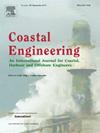A fully spectral framework for nonlinear water waves propagating over topography
IF 4.5
2区 工程技术
Q1 ENGINEERING, CIVIL
引用次数: 0
Abstract
A problem of nonlinear water waves propagating over uneven bottom is considered. The proposed solution is based on a fully spectral Fourier-Galerkin method. Hence, higher-order terms appearing in free-surface and bottom boundary conditions are calculated entirely in a wave number space as convolution sums. In this way, the nonlinear terms may be efficiently determined using either a direct convolution method for smaller kernels or an FFT-based procedure for larger spectral domains. An implementation-ready form of a linear system of equations that bonds velocity potential coefficients at the surface and at the bottom is reported. In static topography conditions, the fast solution of the system is achieved due to precomputed factorization. The numerical model is applied to waves propagating over a bottom of various geometries, including abrupt topographies with upright slopes approximating transformation of waves over a shelf due to a considerable decrease in water depth. The accuracy of the solution is confirmed for a propagation of linear and nonlinear waves of permanent form including solitons, linear and nonlinear shoaling, reflection and transmission of linear waves at an underwater step, and landslide generated linear waves. An application of the method to a tsunami wave undergoing transformation over an abrupt bottom junction is presented along with the discussion on nonlinear wave processes strongly affecting the resulting transmitted tsunami profile.
在地形上传播的非线性水波的全谱框架
研究了非线性水波在不均匀底面上的传播问题。该方法基于全谱傅立叶-伽辽金方法。因此,出现在自由表面和底边界条件中的高阶项完全作为卷积和在波数空间中计算。这样,对于较小的核,可以使用直接卷积方法,对于较大的谱域,可以使用基于fft的过程,从而有效地确定非线性项。本文报道了一种可实现的线性方程组形式,该方程组将表面和底部的速度势系数结合起来。在静态地形条件下,由于预先计算的分解,可以实现系统的快速求解。该数值模型适用于波浪在各种几何形状的底部传播,包括具有直立斜坡的陡峭地形,近似于由于水深相当大的减少而在大陆架上传播的波浪。对于永久形式的线性和非线性波的传播,包括孤子,线性和非线性浅滩,水下台阶线性波的反射和传播以及滑坡产生的线性波,证实了该解的准确性。将该方法应用于海啸波在陡坡底交界处的变换,并讨论了强烈影响透射海啸剖面的非线性波过程。
本文章由计算机程序翻译,如有差异,请以英文原文为准。
求助全文
约1分钟内获得全文
求助全文
来源期刊

Coastal Engineering
工程技术-工程:大洋
CiteScore
9.20
自引率
13.60%
发文量
0
审稿时长
3.5 months
期刊介绍:
Coastal Engineering is an international medium for coastal engineers and scientists. Combining practical applications with modern technological and scientific approaches, such as mathematical and numerical modelling, laboratory and field observations and experiments, it publishes fundamental studies as well as case studies on the following aspects of coastal, harbour and offshore engineering: waves, currents and sediment transport; coastal, estuarine and offshore morphology; technical and functional design of coastal and harbour structures; morphological and environmental impact of coastal, harbour and offshore structures.
 求助内容:
求助内容: 应助结果提醒方式:
应助结果提醒方式:


